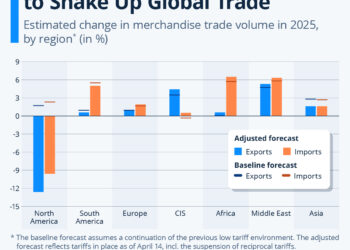The Impact of Political Climate on U.S. Travel: A Closer Look at European Sentiments
The Shift in Travel Trends
Recent developments in U.S. political leadership, particularly during the Trump administration, have led to noticeable shifts in international travel patterns. The interplay of political sentiments, policy changes, and global perceptions plays a crucial role in shaping the travel decisions of potential tourists. Ceylan Yeğinsu’s reporting in the New York Times highlights a significant decrease in interest among international travelers, particularly from Europe, towards visiting the United States.
Tourism Economics’ Revised Forecast
Initially, the research firm Tourism Economics had forecasted a robust growth of 9% in international travel to the U.S. for a particular year. However, amid rising concerns over the political climate, this projection was drastically revised to indicate a contraction of 5%. This change underscores the increasing impact of leadership styles and rhetoric on global travel decisions, revealing a shift that could have long-lasting implications for the tourism industry in the United States.
European Travelers Rethinking Their Visits
Declining Numbers from Germany and France
Among the notable changes, data from the National Travel and Tourism Office reveals a marked decline in the number of travelers from Germany and France to the U.S. between February 2025 and February 2024. Specifically, Germany experienced an 8.5% decrease in tourist arrivals, while France saw a 5.6% decline. Such figures suggest a significant reconsideration of travel plans among Europeans, driven in part by the political climate and policies perceived as unwelcoming or controversial.
Other Western European Trends
Further analysis indicates a 3.9% decline in travelers from other countries in Western Europe during the same timeframe. This trend signals a broader sentiment among Europeans who are reassessing their travel options in light of the current U.S. political environment. It appears that the discourse surrounding immigration, national policies, and diplomatic relations has influenced not only the perception of the U.S. but also the willingness of Europeans to engage with it through tourism.
Contrasting Figures from the UK and Italy
Interestingly, not all European countries are following the same downward trend. The United Kingdom reported a 6.9% increase in travelers heading to the United States between February 2024 and February 2025. Similarly, Italy exhibited a marginal increase of 0.1%. These figures suggest that while some countries are pulling back, others may not be as affected by the prevailing political attitudes, pointing to a complex tapestry of travel motivations and decisions within Europe.
Conclusion
The landscape of international travel, particularly from Europe to the United States, is clearly influenced by the prevailing political climate. As travelers reconsider their itineraries in response to the Trump administration’s policies, the shift in tourism dynamics presents both challenges and unique opportunities for the U.S. travel industry. Understanding these trends is essential for stakeholders looking to navigate the evolving global tourism landscape.






